
Aaron Roth – HOPE International – July 2011
“What are you looking at?” is a far different question than “What do you see?” One implies a line of sight, and the other implies a vision. A lot of times, when I’m out in the communities talking with a HOPE client or a local pastor, they will explain the plans of a dream or an idea to me, and point off into the distance. I try to look and see what they are pointing at, and I say to myself, “I really don’t see anything” and I feel kind of lost. I know that I need to remind myself that I must try to put myself into the vision of the leader. They are not speaking about what currently exists, but rather the kinds of things that can be. Hearing the way that they tell the story with such enthusiasm and confidence, I start to believe these plans could be made real, and amazingly, I start to see it.
What Do You See?
Pastor Domingo is building a commercial grade water filtration project in his church that resides in the middle of a ghetto called “Barrio Blanco” in San Pedro de Macoris. Locally, they call this kind of place “caliente” which means “hot” in Spanish and is used to signify a place that has a lot of crime, violence, and prostitution. The consistent lack of running water and electricity also means that this place gets to be almost unbearable in the heat of the summer. Talking with Pastor Domingo, I was getting a little lost with all of his descriptions about the upcoming plans for the water filtration system, the classrooms, and the programs for youth and adults. I said to myself, “All I see is broken down walls and floors that need repair.”
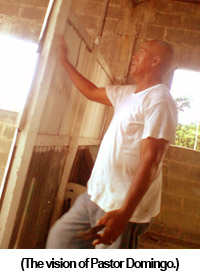
He continued and said, “When we get the water project in place, we’ll be able to provide 5 gallons of water for 15 pesos (45 cents), that’s 10 pesos cheaper than a local store. But I really view it as a way for us to connect ourselves to the community, to provide clean water and start programs that will help to build up and strengthen this community . . . do you see it now?”
I felt like he was saying, “Do you see how a church in the middle of one of the toughest places of the city is providing refuge in the chaos? Do you see how a church invites people to drink the kind of water that will satisfy a greater thirst?” Talking with a man like Pastor Domingo, you really get a taste for the vision of the work he’s planning for the next few years, and if you talk to his local neighbors, you’ll learn that he has a track record of making things a reality in Barrio Blanco. I asked a fellow loan officer, “So what else do you look for besides the financial history of a church like this one.” “Well, maybe more importantly, we look for the strength of the character in the leader of the program. A man like Pastor Domingo is a man that does what he says and people put their confidence in him.” It’s clear that so many neighbors and loan officers in Esperanza see the vision of the church with the same eyes as Pastor Domingo.
Connecting a Community from Home and Abroad
One of my greatest joys during my time of service down in the Dominican Republic was when my church, West End Presbyterian in Richmond, VA came to see a vision for the work that HOPE International is doing. Pastor Kevin Greene, Doug, Jay, Ed, Gary, and Chris from WEPC and Pastor Clint Dowda and Ted from Grace Community Presbyterian Church spent about a week visiting the community projects of HOPE International, Esperanza Internacional, and a partner organization “Network of the Way.”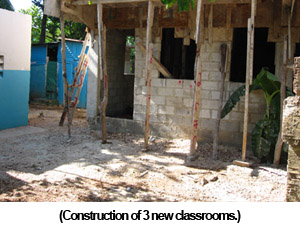
We had the opportunity to visit two community banks in the rural community of Hato Mayor, and later on we visited a school project with HOPE’s partner organization, Esperanza Internacional. I’ve talked a bit about this school program where Esperanza lends money to private Christian schools to help build more classrooms or computer/science labs in previous newsletters. Every time I meet a school director, I am so inspired by their vision and their leadership of the school in the community where they reside. Teresa from “Escalerita ABC” greeted us warmly as we walked through the gate of her school. With a loan from Esperanza, she is building three classrooms and fixing two classrooms to add another 50 students to her school of 200. About seven years ago, her neighbors encouraged her to tutor their children in an after school program. The program became so popular she was convinced to start her own school.
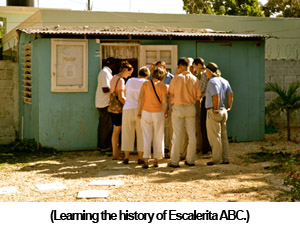 Teresa walked us over to the old school building and said that she started the school in one room with about 15 children. In those days, she didn’t know how she would be able to continue the school. She didn’t have money for desks or blackboards and had to keep the finances tightly under control to make sure the teachers got paid. When they didn’t have enough desks, she said that she had to seat children on a small bench. “Oh wait, I can show you this bench! We still use it!” She briskly walked over to a newer building and pulled out this bench. It’s like she kept a reminder of what things were like seven years ago with one building, and held onto it as a reminder of a vision come to reality. But for her, the school still runs on a tight budget so they still use it for current students! (You know, in the states we sometimes keep things for posterity sake, but in this case, she still uses it for posterior sake.)
Teresa walked us over to the old school building and said that she started the school in one room with about 15 children. In those days, she didn’t know how she would be able to continue the school. She didn’t have money for desks or blackboards and had to keep the finances tightly under control to make sure the teachers got paid. When they didn’t have enough desks, she said that she had to seat children on a small bench. “Oh wait, I can show you this bench! We still use it!” She briskly walked over to a newer building and pulled out this bench. It’s like she kept a reminder of what things were like seven years ago with one building, and held onto it as a reminder of a vision come to reality. But for her, the school still runs on a tight budget so they still use it for current students! (You know, in the states we sometimes keep things for posterity sake, but in this case, she still uses it for posterior sake.)
By the Tree Where God Meets Me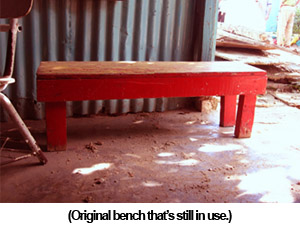
As I stood back and reflected on this moment, it was amazing to me to be standing there with a client of HOPE learning about her story with the church community I had worshiped with over the past four years. It felt to me like we were sharing in the same joys of the Christian walk. God’s promises made real, of answered prayers, and the places where God meets us. Teresa said that the past seven years have not always been easy. She started to choke up when she told us. “It has been so difficult sometimes, and I don’t always know what is going to happen. I know that God has called me to teach these kids and to care for them in this community. So what I do is I sit by this tree, and I pray . . . this is where I come to meet with God.” She continued and said that every time she has prayed here the Lord has answered her. It is in the stillness under the shade of this tree that she feels his presence.
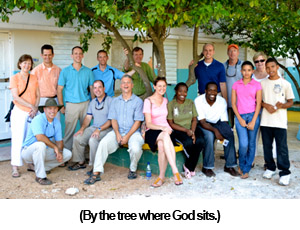 I think all of us took a moment to take in what she was saying. It’s as if she was reminding us that there are places where God calls us to sit with us, to be still and to show us, “what can be.” I think there are so many times when we are so worried about what we see or what we don’t see in front of us. Sometimes we don’t think that any of “this” can be redeemed or changed. It’s like we cannot see when our eyes open, but when we close them and seek God, He can show us a vision of what can be. He can show us the blueprints of a future community center in the midst of a struggling ghetto or a large school that teaches the poorest students of a community. It’s interesting to me that when I have these conversations with these leaders in the country, I can usually hear a local corner store play the typical Carribean Merengue, but strangely, I still find myself thinking about an Irish hymn:
I think all of us took a moment to take in what she was saying. It’s as if she was reminding us that there are places where God calls us to sit with us, to be still and to show us, “what can be.” I think there are so many times when we are so worried about what we see or what we don’t see in front of us. Sometimes we don’t think that any of “this” can be redeemed or changed. It’s like we cannot see when our eyes open, but when we close them and seek God, He can show us a vision of what can be. He can show us the blueprints of a future community center in the midst of a struggling ghetto or a large school that teaches the poorest students of a community. It’s interesting to me that when I have these conversations with these leaders in the country, I can usually hear a local corner store play the typical Carribean Merengue, but strangely, I still find myself thinking about an Irish hymn:
“Be thou my vision, O Lord of my heart,
be all else but naught to me, save that thou art;
be thou my best thought in the day and the night,
both waking and sleeping, thy presence my light.”
I pray that you have a place where God meets you, where God can show you what is and what can be.
Blessings,
-Aaron
aroth@hopeinternational.org
www.AaronRoth.net
Skype: aprothwm05
 My uncle told me that I should pack a suitcase half-full when I left for Latin America for the first time. “It’s not for the souvenirs,” he said, “it’s so that you’re ready to receive something that you want to carry with you where you continue traveling.” That piece of advice has stuck with me for quite some time, and indeed I think I’ve found something I want to continue traveling with.
My uncle told me that I should pack a suitcase half-full when I left for Latin America for the first time. “It’s not for the souvenirs,” he said, “it’s so that you’re ready to receive something that you want to carry with you where you continue traveling.” That piece of advice has stuck with me for quite some time, and indeed I think I’ve found something I want to continue traveling with. happened in the Western world, at least from my perspective, is that we’ve found so many ways to mediate our “connection” to one another that we’ve lost the fundamental touch points. Or in other words, “we’re not getting any closer to what we really wanted to get close to.”
happened in the Western world, at least from my perspective, is that we’ve found so many ways to mediate our “connection” to one another that we’ve lost the fundamental touch points. Or in other words, “we’re not getting any closer to what we really wanted to get close to.”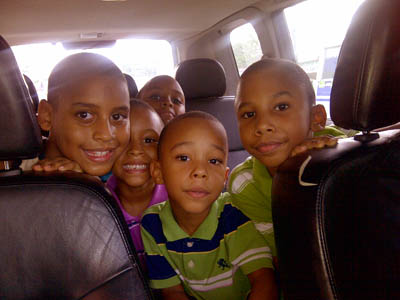
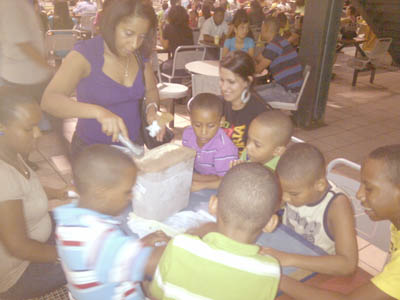 I’d like to think that they “are getting closer to what they really want to be close to.”
I’d like to think that they “are getting closer to what they really want to be close to.”
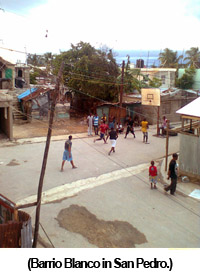


 Teresa walked us over to the old school building and said that she started the school in one room with about 15 children. In those days, she didn’t know how she would be able to continue the school. She didn’t have money for desks or blackboards and had to keep the finances tightly under control to make sure the teachers got paid. When they didn’t have enough desks, she said that she had to seat children on a small bench. “Oh wait, I can show you this bench! We still use it!” She briskly walked over to a newer building and pulled out this bench. It’s like she kept a reminder of what things were like seven years ago with one building, and held onto it as a reminder of a vision come to reality. But for her, the school still runs on a tight budget so they still use it for current students! (You know, in the states we sometimes keep things for posterity sake, but in this case, she still uses it for posterior sake.)
Teresa walked us over to the old school building and said that she started the school in one room with about 15 children. In those days, she didn’t know how she would be able to continue the school. She didn’t have money for desks or blackboards and had to keep the finances tightly under control to make sure the teachers got paid. When they didn’t have enough desks, she said that she had to seat children on a small bench. “Oh wait, I can show you this bench! We still use it!” She briskly walked over to a newer building and pulled out this bench. It’s like she kept a reminder of what things were like seven years ago with one building, and held onto it as a reminder of a vision come to reality. But for her, the school still runs on a tight budget so they still use it for current students! (You know, in the states we sometimes keep things for posterity sake, but in this case, she still uses it for posterior sake.)
 I think all of us took a moment to take in what she was saying. It’s as if she was reminding us that there are places where God calls us to sit with us, to be still and to show us, “what can be.” I think there are so many times when we are so worried about what we see or what we don’t see in front of us. Sometimes we don’t think that any of “this” can be redeemed or changed. It’s like we cannot see when our eyes open, but when we close them and seek God, He can show us a vision of what can be. He can show us the blueprints of a future community center in the midst of a struggling ghetto or a large school that teaches the poorest students of a community. It’s interesting to me that when I have these conversations with these leaders in the country, I can usually hear a local corner store play the typical Carribean Merengue, but strangely, I still find myself thinking about an Irish hymn:
I think all of us took a moment to take in what she was saying. It’s as if she was reminding us that there are places where God calls us to sit with us, to be still and to show us, “what can be.” I think there are so many times when we are so worried about what we see or what we don’t see in front of us. Sometimes we don’t think that any of “this” can be redeemed or changed. It’s like we cannot see when our eyes open, but when we close them and seek God, He can show us a vision of what can be. He can show us the blueprints of a future community center in the midst of a struggling ghetto or a large school that teaches the poorest students of a community. It’s interesting to me that when I have these conversations with these leaders in the country, I can usually hear a local corner store play the typical Carribean Merengue, but strangely, I still find myself thinking about an Irish hymn: